W. H. BULLOCH CHICAGO ANTIQUE BRASS BIOLOGICAL MICROSCOPE NO 2 WithWOOD CASE 1888

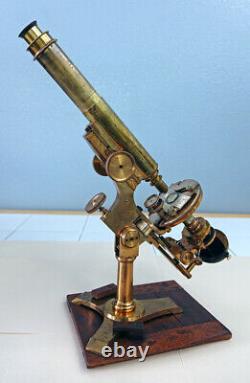
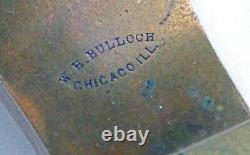
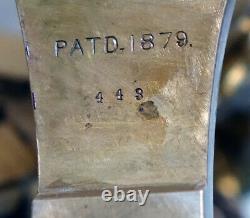
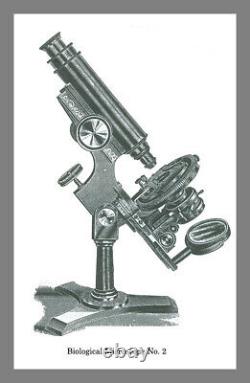
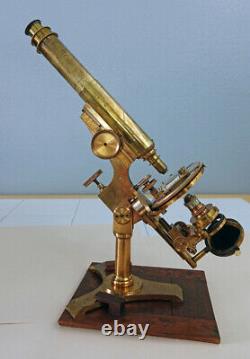
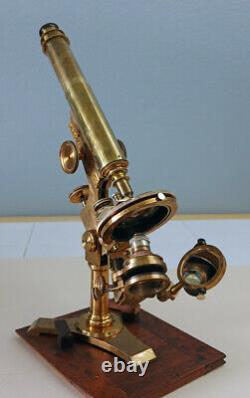
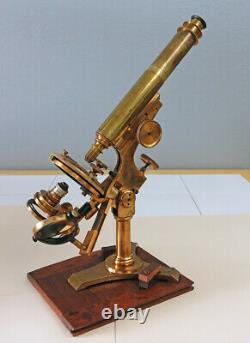





BULLOCH CHICAGO ANTIQUE BRASS BIOLOGICAL MICROSCOPE NO 2 WITH WOOD CASE - SN-443 CIRCA 1888. BULLOCH CHICAGO ANTIQUE BRASS BIOLOGICAL MICROSCOPE NO. 2 WITH WOOD CASE SN-443 CIRCA 1888. 2 Microscope made by Walter H. Bulloch of Chicago, Illinois in the latter part of the 19th Century.
This instrument comes with a wood plinth upon which the microscope is mounted for insertion into its original wood cabinet that has a working lock with key. Included accessories include 2 objective lenses one by William Wales and another by H. And a pair of Bulloch top-hat style eyepieces. The instrument also bears the engraved serial number, 443 along with the Patent date of 1879, which are found on the underside of the same foot that contains the makers name (see close-up images that show these features). The serial number dates the instrument to circa 1888. NOTE: For more information on W. Bulloch, microscope maker, please see below. The 1879 patent date engraving on this microscope refers to US Patent No. 215,878 that was granted to W.Bulloch on May 27, 1879 for several improvements to the design of the microscope including, first, to simplify and provide a more efficient means for using the substage mirror and other substage condenser accessories so that they can act independent of one another; second, to provide a more efficient method of perfecting the fine adjustment using a multi-part articulating long lever system; and, third, to simplify the adjusting of the stage to the optical axis. All three of these patented features are found on this instrument.
Note: Upon request, I will provide to the new owner of this instrument a complete copy of this patent that includes 2 pages of detailed illustrations and 2 pages of text. Bullock is known to have made two (2) successive versions of his Biological Microscope. The initial version that was most likely introduced in 1879 was originally called the New Biological Microscope but was later called the Biological Microscope No.
This version featured a short single pillar on a flat tripod foot, dual swinging tailpieces, a saddle fitting to support the stage, and the patented long-lever fine focus system. The body tube length was five inches, but with the draw tube extended, it could be increased to about ten inches total. The tailpieces on the Biological No. 1 were usually zig-zag or Z-shaped.
Although the substage condenser apparatus was on a separate tailpiece from the mirror, its adjustment was by manually moving it on the tailpiece either up closer to or down away from the stage. 2 was introduced at a slightly later date and was similar to, but more complex than the No.Its most distinguishing features included straight rectangular tailpieces and the addition of a rack and pinion adjustment for the substage condenser apparatus. This version was produced from circa 1880 to 1890. Accompanying this listing is a catalogue cut of the Biological Microscope No.
2 extracted from my personal copy of Bullochs 1890 Microscope Catalogue. Its exact resemblance to the listed instrument is readily apparent.
After Bullochs death in 1891, the Meyrowitz Brothers of New York City, who were Bullochs US sales agents while he was still alive, acquired all the physical plant and rights to produce Bullochs microscopes for a time during the 1890s. During this time frame, they made some further improvements to the No. 2 Biological Microscope that, for example, included angled rackwork for coarse focus. They also renamed it the New Bulloch Bacteriological Microscope. Note: Please see the Bulloch history below for more details on the business relationship between Bulloch and the Meyrowitz Brothers.
This microscope is built upon a lacquered brass flat tripod base. Rising from the center of the base is a cylindrical lacquered brass pillar that rises to a compass joint that supports the limb and, in turn, the rest of instrument. The compass joint allows the instrument to incline to any angle from the vertical for the comfortable viewing of slide preparations mounted atop the stage.
Of special interest is the fact that the pillar is mounted on a brass turntable of sorts that allows the entire instrument to be rotated a full 360 degrees on the tripod base. There are linear marks engraved on both the turntable and tripod base for the positions that face the center of the single leading foot and the center point of the Y-shaped space between the other two feet of the base. These marks are evidently designed to designate the most stable positions for the instrument. The leading edge of the limb of this microscope is notched at the compass joint to allow for a space between the limb and the brass stage support ring.
Instead of the stage being attached directly to the leading edge of the compass joint as in many other microscopes, the stage on this instrument is mechanically attached to an upper portion of the limb above the notch by an L-shaped bracket or saddle so as not to interfere with the space between the compass joint and the rear of the stage support bracket. This arrangement is described and illustrated in the Bulloch Patent noted above. The reason for this design feature will become more evident as you read on. This instrument is equipped with a 98mm diameter circular mechanical stage with a moveable slide carrier. The mechanical stage can be manually rotated a full 360 degrees within its support ring.
At the front of the stage ring is a small brass milled head that acts on a brass tab within the support ring to arrest or relax the stage rotation. It also acts to hold the mechanical stage within the support ring. This mechanical stage is unusual in that the concentric controls for the x-y movement of the slide carrier are mounted vertically atop the stage rather than horizontally as found on most other microscopes.
The x-y movements are controlled by dual concentric brass milled heads that work separate rack and pinion mechanisms that move the slide carrier. The slide carrier itself has a 25mm diameter central aperture and is equipped with a single adjustable slide retainer. Tolles designed a low profile mechanical stage with vertical controls for some of his instruments. It is possible that Bulloch borrowed this design concept from Tolles as he worked with Tolles in Boston for a time before returning to Chicago (see Bulloch history below).
Filling the space between the leading edge of the compass joint and the rear of the stage support bracket are two (2) independent straight rectangular tail pieces one holding a brass mounted plano-concave mirror and the other holding an elaborate condenser apparatus. The upper circular portions of these tailpieces are engraved with angle notations.
There is a tension adjustment knob for the tailpiece rotation found at the rear of the limb (see accompanying image that shows this). The pivot point for these tail pieces is the center of the leading edge of the compass joint. This allows both of the tailpieces to rotate independently around the axis of the stage.
For example, both the mirror and condenser can be worked in tandem below the stage to provide oblique illumination. Then too, the tailpiece with the mirror can be rotated to above the stage to provide incident light to illuminate opaque objects atop the stage (please see the accompanying composite image that shows the versatility of this arrangement). This appears to be Bullochs version of the swinging substage mirror assembly that was first invented and patented by Joseph Zentmayer in the year 1876.
The sides of the mirror bar tailpiece form a male dovetail supporting a smaller female dovetail piece that slides along the bar and supports the substage plano-concave mirror. The plano side is 55mm in diameter while the concave side is 45mm in diameter.
The mirror can be manually moved either closer to or away from the stage along the mirror bar. The other tailpiece holding the condenser assembly is more complex than that holding the mirror. It consists of two (2) closely nested parts a rectangular base brass bar and a second brass bar containing rackwork that can be rotated completely away from the base bar by pivoting on a side mounted hinge. The condenser assembly also consists of two (2) parts A pinion gear assembly that is attached to a conventional condenser holder and an upper swing-in/swing-out condenser holder that is designed to hold a wide aperture RMS threaded objective that acts as a condenser.
The pinion gear assembly is controlled by a pair of brass milled heads found on either side of the unit. These milled heads allow the entire assembly to be raised or lowered on the bar containing the associated rackwork.
This part of the assembly also contains two (2) set screws that permit the centering of the housing within the optical axis. In this case, mounted on the upper swing-out assembly is an adjustable RMS objective lens that is unmarked except for the engraving Tubus l. Coarse focus is by rack and pinion controlled by a pair of oversized brass milled heads found on either side of the limb. The rackwork on this instrument is horizontal rather than angled as is the case for all of the instruments made by Bulloch. Fine focus is by micrometer screw acting on a through-the-limb multi-part articulating lever device that is described and illustrated in the 1879 Bulloch Patent.
Fine focus is controlled by a milled head mounted atop the limb. The top of the milled head is engraved with a number scale. The body tube of this microscope includes a 4.75-inch long drawtube.
At the top of the drawtube is a lacquered brass ocular holder. A pair of top-hat style oculars are provided with this instrument One marked with the number 6 and the other marked with the number 9.The lower end of the body tube is threaded for RMS objectives. Two (2) objective lenses are provided with this instrument A 2/3-inch objective marked W. Y and a 1/8-inch marked H. Along with the number 513, which may be a serial number or part number.
Both of these objectives are housed in appropriately marked brass objective canisters when not in use on the microscope. These objectives in their cases along with two eyepieces are stored in a removable accessory drawer found in the top of the wood case that houses the microscope. NOTE: Bulloch did not manufacture his own objective lenses. Thus, he and/or his representatives including the Meyrowitz Brothers supplied objectives with the microscope made by others including Wales, Tolles, Spencer, B&L or Gundlach.When this instrument is set up for observations with the drawtube fully extended, it stands about 17 inches tall, making for a relatively large antique brass microscope (please see the accompanying image which compares the size of the microscope to a standard bottle of wine). When the instrument is to be stored in its wood case with the eyepiece and an objective removed and when the drawtube is fully nested into the body tube, the instrument stands about 12 inches tall in its collapsed state. The microscope weighs 10 pounds. Included with the microscope is its original dovetailed wood cabinet with brass carrying handle and a working lock with key. Also included is a wood plinth on which the microscope is mounted and easily slid into the case for storage.
Included inside the top of the case is a wood accessory drawer that holds the objectives and eyepieces. The exterior dimensions of the case are 13.5 inches tall, 8 inches wide and 9.25 inches deep. The microscope in its case with the noted accessories weighs 18 pounds. NOTE: The accompanying images that were captured under ambient light conditions are a part of this statement of condition.
Please take the time to view each of the images so you can confirm the condition of the instrument and so you will know in advance what you will be getting should you prove to be the proud new owner of this superbly designed and engineered American made microscope. In summary, this Bulloch microscope is in very good to excellent cosmetic, optical and mechanical condition, but with a few minor caveats as noted below. The cosmetic condition of this instrument is exceptionally good for an instrument of its age. Most of the original lacquer is still present on the brass parts with just a modicum of spotty tarnish present especially on the top of the triangular base, the sides of the body tube, on the stage and some surficial tarnish present on the drawtube. I would estimate original lacquer retention at around 95%. The only treatment we have given this instrument was to clean it of dust and grime with dilute Windex and then to give it a coating of Renaissance Wax from the GEMMARY to protect it.NOTE: WE MAKE IT A GENERAL PRACTICE NOT TO DEEP CLEAN AND POLISH ANTIQUE BRASS MICROSCOPES. The optics associated with this instrument (eyepieces & objective lenses) are in very good to excellent condition with no internal defects.
However, I did note that the Spencer 1/8-inch objective was difficult to come into focus due to its rather razor thin focus range. Several antique prepared slides viewed with this instrument equipped with the Wales objective provided excellent well resolved images at the eyepiece.
Accompanying this listing is a composite image showing three (3) prepared specimen slides that were viewed with this instrument with the Wales 2/3-inch objective and the objective condenser in place on the instrument. The plano side of the plano-concave mirror is in excellent condition.
However, the concave side shows a slight loss of silvering around its very edge. It provides excellent illumination to the stage. The mechanics associated with this instrument are in relatively good condition overall, but there are some exceptions worthy of noting.
The coarse focus mechanism works smoothly and perfectly. However, the fine focus works only in the upward direction. The normal spring actuated return on the downward movement does not work, probably due to some unknown internal age issues that would require full disassembly of the mechanism to investigate further.
In addition, the pinion gear on the condenser assembly is worn and so does not impact the associated rack, which does not allow the condenser assembly to be moved up or down on the tailpiece using the milled heads. On the other hand the stage rotates freely, the arrest mechanism works as designed and the x-y movements of the slide carrier are smooth and precise. In addition, the swinging tailpieces work smoothly and the associated tension mechanism works as designed.
There is one other design problem associated with the condenser assembly that bears mention. The milled heads associated with the condenser centering adjustment and those that move the assembly up or down on the tailpiece interfere with one another at certain points.
This is one design flaw that was corrected by Meyrowitz brothers when they redesigned the substage of this instrument after Bullochs death. They solved this conflict by moving the condenser centering screws to the front of the assembly. All of the aforementioned mechanical issues will likely be academic for serious antique microscope collectors as this instrument will most likely be placed into a collection on display and will not be used on a day to day basis in a laboratory setting where mechanical precision of all parts is required.
The Mahogany wood case is in good to very good condition. However, typical of such cases there are some age splits, scrapes, scratches and dings from use over the years on both the interior and exterior of the case. It is the original case for the instrument and has both a working lock and key. The wood plinth that accompanies the case is in good serviceable condition, but it has some missing wood on one side and an age split. However, its structural integrity is not compromised by these age imperfections.The accessory drawer associated with the case is in good condition. All in all, this instrument is a very well preserved example of a Bulloch Biological Microscope No. It is certain to command a prominent place in any antique microscope collection, especially one with an emphasis on American made instruments. A word of advice though: All W. Bulloch instruments are very rare birds and in high demand by collectors, so you will need to act quickly to make this microscope your own!
Walter Hutchison Bulloch (1835 1891) was born in 1835 in Glasgow, Scotland where he lived until age 17. About 1852, he and his family immigrated to New York City in the United States. Here young Walter learned the trade of a tailor from his father. However, his innate fondness for mechanical pursuits made him dissatisfied with his future prospects as a tailor.
He soon became apprenticed to Messrs. Pike & Sons, then a leading firm of opticians and scientific instrument makers located on Broadway in New York City. After serving for a time as an apprentice with the Pike firm, he decided to open his own optical-mechanical workshop in the City.But, not long after this, the US Civil War broke out and Bulloch decided to enlist as a private in the 12th New York Volunteers on the Union side of the conflict. Back in New York City he formed a business partnership with William Wales, a well-known maker of objective lenses. He continued in business with Wales until the year 1866, when Bulloch moved to Chicago, Illinois. In Chicago, Bulloch proved to be very successful and had accumulated considerable means over the period of 1866 to 1871.
During this time frame his business address was listed at 126 Clark Street in Chicago. This proved to be his most productive period when it came to microscope production. Then, on October 8 & 9, 1871, a disastrous fire completely consumed his shop and tools as well as some microscopes that he had under construction at the time. As a result of this misfortune, Bulloch suffered a significant financial and psychological loss from which he never fully recovered. In an attempt to rise from his misfortunes, he moved to Boston and was for a time associated with another famous American optician, Robert B. Tolles of Boston Optical Works. Another address for his business in 1876 was at 102 Madison Street. However, in 1889, still suffering financially, he accepted a position with the Bureau of Weights and Measures in the U. Coast and Geodetic Survey in Washington, D. But, he soon chafed under the beaurocratic restraints associated with working for a US government agency. Even though he continued to suffer from poor health his perseverance led him to struggle on with his microscope business. He opened a new place of business at No. 303 Dearborn Street, a very advantageous business address, and began to work again. However, it was not for long. After struggling with ill health for about six months, he was forced to stop work.Bulloch died on November 5, 1891 at Elgin, Illinois where he had gone for treatment. Bulloch, including all patents, models, drawings, etc.
They continued to manufacture his microscopes under the Bulloch name for a time. They used residual parts left by Bulloch to assemble the instruments and evidently started a new set of serial numbers unrelated to the numbers used by Bulloch. They also made modifications to Bullochs original designs including the addition of diagonal racks/spiral pinions for coarse focus along with improved substage apparatus and other minor design changes. Some of these latter instruments were signed variously as Bullochs Patent, Meyrowitz Maker or E. Meyrowitz - Maker - New York - Bulloch's Patent 1879.
The firm likely ceased manufacturing operations completely before the year 1900, producing relatively few instruments in total. Due in part to combinations of misfortunes and ill health, Bulloch produced less than perhaps 750 microscopes over his lifetime. Note: As of 2020, serial numbers 52 to 675 plus a scant few without any serial numbers are documented by the antique microscope collection community. But each of his instruments reflects his rapt attention to detail and his ardent desire to achieve a high level of perfection in terms of optical and mechanical performance. He constantly experimented with new enhancements and made continual improvements to his instruments over time.
As a result, his surviving microscopes, which rarely surface, are in extremely high demand by collectors. THE MONTANA LOGGER is very pleased to offer this W.Bulloch Antique Brass Biological Microscope No. We will also entertain reasonable offers for this rare instrument. Rather, we will remove all of the loose accessories from the microscope stand and wrap the stand in a thick "cocoon" of bubble wrap so it will look like a "bubblewrap football" when completed.
All loose accessories will be wrapped individually in bubble wrap and placed inside the wood case. We will fill all remaining voids in the wood case with crumpled newspaper so nothing can move around in transit and then wrap the wood case in bubble wrap. Using these tried and proven packing methods, the microscope and case will arrive safe and sound at your destination.
FREE scheduling, supersized images and templates. Make your listings stand out with FREE Vendio custom templates!
Over 100,000,000 served. Get FREE counters from Vendio today! BULLOCH CHICAGO ANTIQUE BRASS BIOLOGICAL MICROSCOPE NO 2 WithWOOD CASE 1888" is in sale since Friday, November 27, 2020. This item is in the category "Collectibles\Science & Medicine (1930-Now)\Scientific Instruments\Microscopes, Lab Equipment". The seller is "mtloggera" and is located in Hamilton, Montana.
This item can be shipped worldwide.
- Antique Brass Microscope: Biological Microscope No. 2
- Serial Number: 443
- Manufacturer: W. Bulloch
- Product Type: Microscopes, Lab Equipment
- Country/Region of Manufacture: United States, Chicago, Illinois
- Time Period Manufactured: Circa 1888

